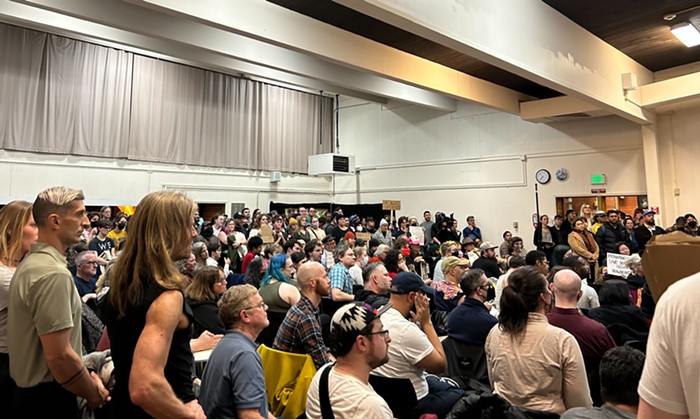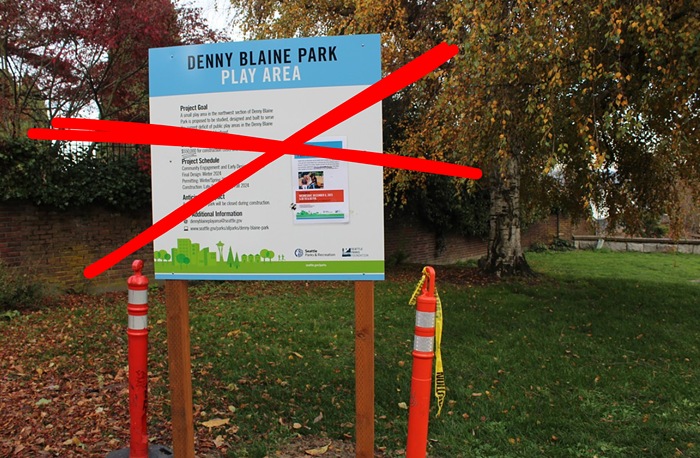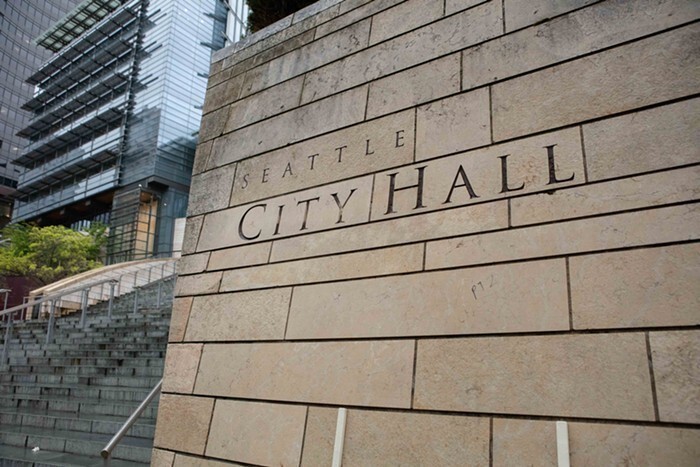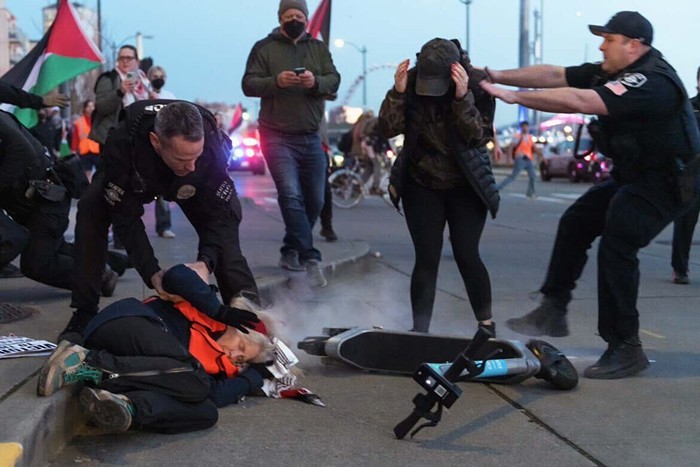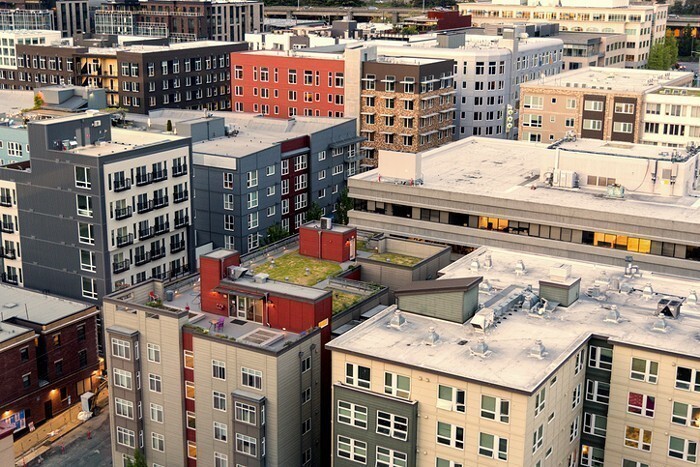It's midmorning at Garfield High, and a handful of black teenagers stand gossiping on the concrete that meets the school's back steps. A busy street runs close by, on the other side of which stands a row of run-down houses. "Where you supposed to be?" barks school security guard Michael Dixon. The group falls silent for a moment and looks at Dixon. "I don't have a class," one girl responds, happy to have a legitimate answer. Dixon gets a little pissed at the response -- not because the girl seems insolent, but because the school hasn't provided her a full day's schedule.
"This is acceptable, apparently," the dreadlocked Dixon says to me, rolling his eyes. Dixon, who comes off as stern and kind at the same time, adds that it's okay "for some kids to hang out." A former Black Panther, Dixon says black kids at Garfield are being neglected and left behind while white kids excel. (I look around and the only white kids I see in the vicinity are a cluster in the hallway, reading Shakespeare to one another.) The Seattle school district, Dixon says, has "built a white, racist program starting with busing. Black kids aren't getting what they need. They're watching the white kids get everything."
Dixon's not the first to point out that Garfield exists as a school within a school. The numbers speak for themselves. On one hand, Garfield boasts the best academic reputation of any high school in the city. It has the most merit scholars in the state and nearly half the Advanced Placement students in the Seattle school district. Yet, there is a second, less-than-world-class school within Garfield. During last year's round of Washington Assessment of Student Learning tests -- which rank students according to skills in reading, writing, math, and listening -- the school fell far below state standards in two categories. Garfield officials claim that many students didn't show up to take the test, accounting for the low scores. But even fancy tests aside, nearly one third of all Garfield students are failing or getting a D in at least one course required for graduation.
To make matters worse, the students who are doing well tend to be white, while the students who are doing poorly tend to be black. The student population at Garfield -- situated in the heart of the Central District -- is estimated by the school district to be 47 percent white, 35 percent black, 13 percent Asian, 4 percent Latino, and 1 percent Native American. Yet, 73 percent of students in the advanced classes at Garfield are white, while 19 percent are Asian and only 4 percent are black (Latinos and Native Americans together make up 4 percent of Advanced Placement classes). On the other end of the scale, 62 percent of all African American students at the school are on the "D and E list" (which is, itself, made up of mostly black students), meaning they are in danger of flunking out.
Excuses for the disparity range from complaints that black students don't want to excel and show up at Garfield unprepared for advanced classes to accusations that the school has set up purposeful barriers to keep black kids at a disadvantage. Ironically, as one of the more diverse inner-city high schools in Seattle, Garfield was once lauded by students as a "model for integration success." These days, it's considered a failure. "The first floor is black people, the second floor is white, and the third floor, I don't know," says junior EunJean Song, who's part white and part Asian. "We see it every day and nobody's doing anything about it."
Welcome Whitey
Garfield was a neighborhood school when it was built back in 1922. The Central District was mostly white at the time, and early yearbooks are filled with white faces. But by 1956, two years after the Supreme Court decided to integrate schools with its Brown v. Board of Education of Topeka, Kansas ruling, which said separate and equal is inherently unequal, Garfield made integration a priority.
In fact, school officials bragged about Garfield's growing diversity. A 1956 article published in The Seattle Times quoted Garfield faculty members who challenged racist research by arguing that black students were as smart as whites. That's also the year a group of five students wrote their own article, published in the Times, dubbing Garfield an integration success story: "Visit the heart of our 'integration' -- the classroom," they wrote. "We learn not only 'math,' science, English and history, but always and unforgettably respect for one another. The keen mind of a Japanese boy at work in chemistry class, an exquisite tailoring job done by a girl named Wong, the Negro who draws so beautifully, the Filipino who is good at languages -- we are partners in the quest for knowledge."
By 1974 -- as large numbers of minority residents moved into the Central District -- the school was 81 percent black. School administrators feared that Garfield was becoming ghettoized. They started busing in whites, and by 1979, the number of black students had fallen to 60 percent. This new emphasis on white kids didn't sit well with the student body. That year, Norman Alston, an African American junior at Garfield, wrote an article in the Times entitled, "Blacks at Garfield not getting proper education," charging that the majority of the students in "the most demanding and most vital courses" were white.
That description became even more apt in the years after the Advanced Placement (AP) program came to the school in the mid-'70s. Chosen for its central location, according to Seattle Superintendent Joseph Olchefske, Garfield became one of three schools in the district responsible for fulfilling the state's requirement for gifted learning programs. Certain kids in Seattle are put on the fast learning track as early as grade school (where the program is called the Accelerated Progress Program). That path continues right up through high school, where those kids are assigned to AP classes designed to prepare them for college -- some can even get college credit by passing a $75 test. AP kids get priority at Garfield, both in admissions and class selection -- which has meant that neighborhood kids get left in the dust. As of spring 1999, though the neighborhood was at least 46 percent black (that's according to 1990 census data; the current percentage is probably higher), 73 percent of the 593 students enrolled in advanced classes were white.
And that disparity isn't expected to disappear anytime soon. In the last five years, the school district has expanded its AP program, and Garfield has wound up with more AP classes than any other in the district -- 17 in four subjects -- and is responsible for ordering more than half the college-credit tests in the district. Peller Phillips, who helps run Garfield's Academic Intervention Program for failing students, says the school is so focused on fancy programming (it boasts highfalutin orchestras, jazz bands, sports teams, and math and science classes) and kids who have the greatest potential to go on to college, that it's starting to seem like a snotty prep school. "The fact that they have these honors and AP programs -- it's bringing in whites," he says. "That academic pressure gets more and more intense, and you have this [black] community that's shrinking. It's becoming more an academic school than a neighborhood school."
Sorry, Black Kids
On the first floor of the school, there's a large snack room filled with dozens of mostly minority students in need of remedial help. They sit at long tables, talk with one another, and munch candy bars. Tutors -- some paid, some volunteer -- show up intermittently to answer homework questions. But much of the time, the kids socialize. The chances of these students getting admitted to Garfield's AP program are slim.
They'd have to overcome a number of rather formidable barriers. First, they're already behind academically, and there aren't many programs or classes at Garfield to help them catch up. The Academic Intervention Program, the only program in place to give faltering students a boost, is dramatically underfunded -- it only received $1,200 from the Parent Teacher Student Association last year, and didn't have even one computer until this year. Acting principal Cheryl Chow describes the effort disparagingly: "The program system and planning was thrown together," she says.
"There's an inequity in resources," says Pam Green, Garfield's Parent Teacher Student Association president and the black parent of a struggling Garfield 10th-grader. "The inequity starts in elementary schools, when teachers start labeling kids and putting them in groups.... To me, it's really two camps. It's very disturbing because the AP program is serving less than a third of the school." A study released in March by the Applied Research Center, a think tank in Oakland, California, bolsters Green's viewpoint. The study found that minority students in just about every state are doing worse than their white counterparts, and noted that school districts exacerbate the problem by trapping kids in largely segregated academic tracks that are almost impossible to escape. As Libero Della Piana, one author of the study, puts it, "Those classes are geared toward you never catching up. Maybe having more AP classes is not the best idea."
Secondly, since almost all AP students are white or Asian, black kids feel excluded and aren't inclined to seek admission. Garfield senior and Associated Student Body President Cecile Cross wrote an article in the student newspaper, Equilibrium, that described being a black honors student. "I feel like a grain of pepper in a salt shaker," he wrote. "Unfortunately, the majority of young black males aren't expected to succeed."
Jim Creighton, head of the history department, is the lead advocate for AP classes at Garfield, and embodies yet another barrier -- teacher attitudes. He refuses to discuss in any detail the lack of black students in his classes, and justifies the overrepresentation of white students by claiming that less is required of black students applying to colleges. The logic, apparently, is that blacks can be lazier because they've got it made. "There are two different sets of circumstances," is all Creighton would say.
"That's saying, 'Okay, so we're not capable of doing AP work,'" says Alisha Liggett, a black Garfield senior and Central District resident, who has taken AP history with Creighton. She has a 3.82 grade point average (GPA) and was recently accepted at Columbia University. Liggett attributes her success in part to her AP classes. Just last month, Newsweek's Jay Mathews reported that access to the AP curriculum "is particularly important in predicting the success of minority students." However, like many black students at Garfield, Liggett finds that white teachers do not always welcome black students into their AP classes.
Nearly all of Garfield's 12 AP teachers are white, and none are black. (This reflects a trend in the school as a whole; only 13 of Garfield's 79 teachers are black.) Yet, according to the 1998 book The Black-White Test Score Gap, a collection of research on racial disparity in test-score results, teachers make the biggest difference in raising test scores, and black students learn more effectively from black teachers on average. One Asian AP student, who asked to remain anonymous, speculates that "if there [were] more competent black teachers, the black students would be much more interested."
When Seattle School District officials were asked about problems at Garfield, they tended to give very vague answers like "diversity is a priority." The district's Chief Academic Officer, June Collins Rimmer, who is supposed to head up efforts to boost academic achievement among Seattle's minority students, didn't even return The Stranger's phone calls. Just about the only specific I could drag out of anyone at the district level came from Lynn Steinberg, a public relations officer. When asked about minority teacher recruitment -- something that members of the teachers' union say has been sporadic at best -- she predictably emphasized that diversity is a priority, but went on to explain that of the 80 new teachers Seattle hired for the next school year, 30 percent are minority.
Denise Wingo, president of a black parent group called the Village Council, calls the racial divide at Garfield "a state of emergency," and accuses teachers of purposefully keeping black students out of advanced classes. Wingo says she was furious when Garfield conducted "tennis-shoe" registration this year. This type of registration is manual, rather than computerized, and allows teachers to select their students. As a result, black students were stuck with classes like physical education courses, she says, which suddenly became disproportionately minority. Interim principal Chow -- who lost a bid for Seattle City Council last year -- says she opposed the registration method, but was outvoted by her staff. "We're not going to do it next year," she promises.
Superintendent Olchefske agrees that teachers shouldn't have control over which students are admitted to their classes. However, he explains, there are other factors that get in the way of progress. "Because those kids are selected by their performance," he says, "there will always be a disparity." This is a sentiment echoed by many administrators in the district, who don't seem to consider that there may be ways to bridge the gap with intermediate classes and learning programs. Olchefske's solution to the admissions problem? Let parents rather than teachers decide to place their kids in the elite classes, a proposal opposed by many parents of current AP students.
Principals throughout the years have made attempts to integrate Garfield's AP classes and boost black students' performance. Al Jones -- who left the school last year after being accused of having an "unprofessional" relationship with a student -- tried at one point to make all classes into honors classes (one step below AP). That effort was shot down because his plan didn't include intermediate classes to get non-honors students ready for a tougher curriculum. Former principal Ammon McWashington, who ran the school from 1977 to 1988 and from 1994 to 1996, tried to push black students into the AP program by giving them convincing pep talks, but he left the school before his attempts could have an effect. Another past principal, Charlie Walker, says he tried to integrate minority students into the AP program while he was at the school from 1996 to 1998. He wrote letters to black parents recommending that their kids register for advanced courses. But, he says, "students either didn't want to do the work or teachers didn't want them in there."
Not Our Problem
Robert Vaughan, who's in charge of the district's "gifted" programs, claims that any good student who wants to get into AP can. "There are no particularly reserved classes or special programs at Garfield," he says. "The opportunities need to be there." But Vaughan is leery of diverting too much attention toward kids who are falling behind. "Don't just create Saturday schools for at-risk children," he says.
Educators like to point the finger away from themselves when it comes time to assign blame for the disparities at Garfield. Racism is a citywide, statewide, even a nationwide problem, they say. And in that regard, of course, they're right. According to the Seattle Young People's Project, a local youth advocacy group, high schools throughout Seattle do poorly when examined for racial equality among dropouts, graduates, expulsions, advanced-class students, and teachers. According to last year's district statistics, the mean GPA for Seattle's black students was 2.2, while the mean for white students was 2.84.
Recent articles in The New York Times and The Wall Street Journal document a national trend away from integration. For example, in March, the U.S. Supreme Court refused to consider race as an admissions criterion, therefore allowing a white Maryland kindergartner to leave his primarily black neighborhood school for a white magnet school across town. Also, a California biology teacher's effort to allow all students, including poor and minorities, into his high school's Advanced Integrated Science program outraged wealthy white parents. They complained that the mix was dragging down their kids, and the program was canned. But does that mean there's nothing that can be done at Garfield? Chow -- who has only been at the school since October, but says she'll stay at least through next year or until a permanent principal is found -- says racial inequity exists because "Garfield has no common goal. It's been a school within a school." She says efforts to create a more cohesive learning environment have been tough going. Attempts at reallocating funding -- say, by moving dollars from small classes to larger ones -- have upset teachers and have been unsuccessful so far. She has managed to boost the budget for the Academic Intervention Program for kids who are behind, however, and promises to spend between $175,000 and $200,000 on it next year.
One thing Chow will do this year, for the very first time, is to evaluate teacher performance. (This change is the result of years of pushing by district school board members like Michael Preston.) Garfield Teen Health Center counselor Catherine Wetzel says this is a major improvement because, in the past, there was no way to get rid of bad teachers. Now, they'll be scored on qualities and achievements like whether they conduct regular roll calls and keep accurate grading records. Chow says there's no way to evaluate whether a teacher discriminates: "As long as behavior here isn't noted as racist, there's nothing I can do."
Language Arts Department head Sonya Scharf is working in her own way to get more kids of color into AP classes. She's been talking with parents and kids to find out why black students aren't enrolling, and she's encouraging them to sign up. "Some of them thought it was selective or that there was a test to get into the classes," she says. "They didn't see themselves as AP students. The thing is, the program is here and it's available to everyone, but that's not good enough."
Ron Pleasant, who helps run the Academic Intervention Program, looks at his measly budget and says the school needs to do more. Much more. "I think they should be coming out with the funding and the programs," he says. "I don't understand why the school district doesn't provide money for at-risk students."
But black security guard Michael Dixon says he understands the reason. He claims that it's part of Garfield's overwhelming attitude: "Oh, well," he says sarcastically, "let the little niggers play with themselves, and we'll teach the white kids something."
